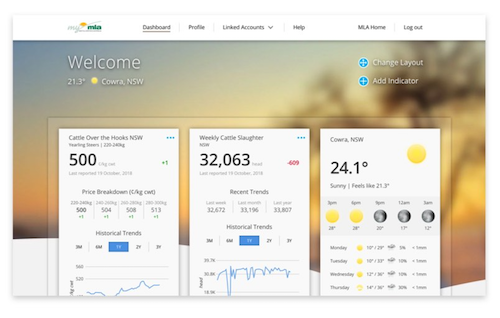Forecast
Lajamanu (18.3388°S, 130.6367°E, 304m AMSL) set as my default location ›
myMLA

 A free online dashboard that provides timely and personalised market indicators and reports, weather, industry news, and other resources to support your business.Learn more
A free online dashboard that provides timely and personalised market indicators and reports, weather, industry news, and other resources to support your business.Learn more-
Current condition
TODAY22° 32° possible shower Chance of rain: 60% Likely amount: 1-5mm First
light

Last light Sunrise Sunset 6:32am CST 6:53am CST 6:51pm CST 7:13pm CST NOW25.1° Feels Like: 29.9° Relative Humidity: 94% Dew: 24.1° Wind: E 6km/h Gust: 9km/h Rainfall since 9am: 0.2mm Pressure: 1008.9hPa TODAY
Possible shower23°33° 60%
60%
1-5mmLajamanu Now
Temperature 25.1° Feels Like 29.9° Dew Point 24.1° Rel. Humidity 94% Pressure 1008.9hPa Wind E 6km/h Wind Gusts 9km/h Rainfall 0.2mm Updated 3:30 AM24-Hour Graph
6:53am
6:32am
6:51pm
7:13pm -
Lajamanu for Sunday,
LajamanuNow24.1°cFeels Like:27.3°Wind:E 11km/hGusts:13km/hHumidity:95%22°Min32°MaxToday in LajamanuPartly cloudy. High chance of showers, most likely in the late morning and afternoon. The chance of a thunderstorm. Light winds.Tomorrow23°Min33°MaxPartly cloudy. High chance of showers, most likely in the afternoon and evening. The chance of a thunderstorm. Light winds. -
Radar

-
Radar
-
Warnings
There are no current warnings for Lajamanu
-
7 day forecast
Today: Partly cloudy. High chance of showers, most likely in the late morning and afternoon. The chance of a thunderstorm. Light winds.
Forecast for Lajamanu (18.3388°S, 130.6367°E, 304m AMSL) Sunday
Mar 30Monday
Mar 31Tuesday
Apr 1Wednesday
Apr 2Thursday
Apr 3Friday
Apr 4Saturday
Apr 522° 32° 23° 33° 22° 32° 19° 30° 20° 31° 20° 31° 21° 33° Possible shower Possible shower Clearing shower Mostly sunny Mostly sunny Mostly cloudy Mostly sunny Rain Chance 60% 70% 30% 20% 20% 10% 20% Rain Amount 1-5mm 5-10mm < 1mm < 1mm < 1mm < 1mm < 1mm UV index Extreme Extreme Extreme Extreme Extreme Extreme Extreme Fire Danger Rating No Rating No Rating No Rating No Rating - - - Frost risk Nil Nil Nil Nil Nil Nil Nil 9am 3pm 9am 3pm 9am 3pm 9am 3pm 9am 3pm 9am 3pm 9am 3pm 13
(km/h)14
(km/h)15
(km/h)18
(km/h)17
(km/h)23
(km/h)13
(km/h)10
(km/h)22
(km/h)18
(km/h)20
(km/h)19
(km/h)22
(km/h)24
(km/h)Wind NNE NNE N NNW NW WNW SSW WSW SE ESE SE ESE SE ESE Humidity 92% 67% 89% 59% 86% 55% 82% 51% 76% 53% 64% 42% 61% 44% Dew point 23°C 25°C 24°C 24°C 22°C 22°C 18°C 19°C 19°C 20°C 17°C 17°C 17°C 20°C First light 6:32am 6:32am 6:32am 6:32am 6:32am 6:33am 6:33am Sunrise 6:53am 6:54am 6:54am 6:54am 6:54am 6:54am 6:55am Sunset 6:51pm 6:50pm 6:49pm 6:48pm 6:47pm 6:47pm 6:46pm Last light 7:13pm 7:12pm 7:11pm 7:10pm 7:09pm 7:09pm 7:08pm -
Popup - Daily historical
-
-
Popup - Monthly historical
 Sign in to myMLA for deeper weather insights.28 Day and 12 Month Rainfall forecast
Sign in to myMLA for deeper weather insights.28 Day and 12 Month Rainfall forecast
Detailed Historical Observations and Climatology



